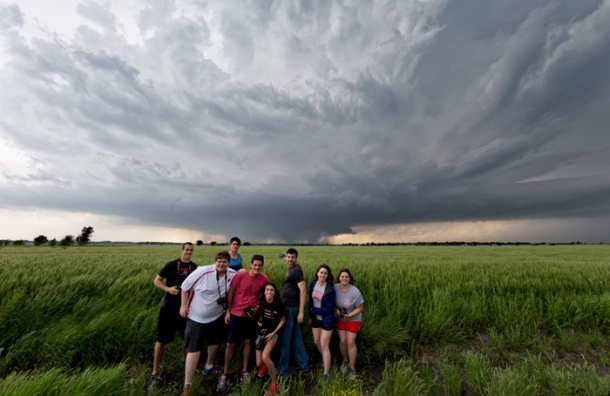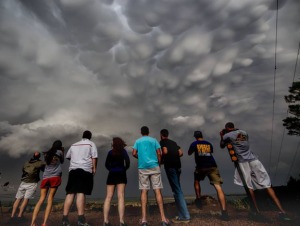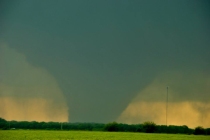
The WKU storm chasers documented four tornadoes including this EF-4 tornado near Bennington, Kan. (Photo by Dr. Josh Durkee)
The May 2013 summer term was the fourth year that Dr. Josh Durkee’s Field Methods in Weather Analysis and Forecasting class set out across the Great Plains, forecasting and verifying a wide variety of severe weather. As with previous years, the WKU group accomplished much success in their mission.
This year Dr. Durkee, along with Dr. Grady Dixon and eight students, traveled 7,115 miles across 10 states (Kentucky, Missouri, South Dakota, Nebraska, Kansas, Oklahoma, Texas, Colorado, Arkansas and Tennessee) to apply various forecasting techniques with regard to severe weather, and to analyze and document the hazardous outcomes as they unfolded. The group documented up to four confirmed tornadoes, including an EF-4 quasi-stationary tornado near Bennington, Kan., as well as number of damaging hail and wind events and flash floods.
The overall purpose of this class is to provide a unique and practical capstone learning experience beyond a traditional classroom setting for students studying meteorology.
“As opposed to many traditional college courses where the instructor makes most of the decisions, in this course the students make many of the decisions,” Dr. Durkee said. “This gives each student a true sense of the real responsibility that goes into weather analysis and forecasting, and forces them to put forth their best efforts at all times. Consequently, the students often finish the course with skill sets well ahead of others who have not taken the class.”
While the decision-making is largely left up to the students, Dr. Durkee still guides their decisions toward the most ideal and safe outcomes.
“As with any field intensive class, the number one rule for this is course is to always practice the best safety measures while targeting the optimal environment from which to learn from,” Dr. Durkee said. “There is a lot more than weather forecasting that goes into the daily routine. We always consider the array of potential obstacles that may hinder our safety and/or learning environment. Such obstacles include navigable roadways, topography, population density, traffic, among others. If any one or combination of these factors intrudes on our ‘classroom,’ we simply avoid that area.”
This year has been a particularly troublesome year as many devastating storms and tornadoes repeatedly hit urban areas surrounding Oklahoma City, which Dr. Durkee’s class avoided altogether.
“I cannot stress enough that our mission for this course is not to test our limitations in the face of these storms in order to see what Mother Nature has to offer,” Dr. Durkee said. “Rather, we follow along from the back row so to speak, in order to comfortably observe, learn from, and respect these incredible and powerful events.”
This year’s group included WKU students Ryan Difani of Pocahontas, Ark.; Will Paschall of Germantown, Tenn.; Tyler Smith of Russellville; Colton Lindsey of Mount Vernon, Ind.; Andrew Schuler of Independence; Tara Wagoner of Lafayette, Tenn.; Ilea Schneider of Lewisport; and Veronica Hall of Livonia, Mich.
Dr. Durkee is assembling the forecast analyses, surface, upper-air, radar, satellite, and GPS data, along with the photography and video documentation to prepare students for upcoming research endeavors, as well as to use these data as learning devices for courses in the upcoming academic school year. Read the student blog entries and view more photos from the 2013 journey on the WKU Meteorology Blog at
http://meteorology.blog.wku.edu/
, on Twitter at
https://twitter.com/wkustormchase
and on Facebook at
https://www.facebook.com/wkumetclimsci
Contact: Josh Durkee, (270) 745-8777



